A Project of the Hudson River Estuary Program
Compiled and edited by Tom Lake, Consulting Naturalist
Love Our NY Lands
State Lands Belong to All of Us
All New Yorkers and visitors should be able to access, enjoy, and feel welcome on state lands. These lands belong to all of us, our families, and our neighbors. While enjoying these shared spaces, be respectful of other visitors. Share trails, treat people with kindness, and leave things as you found them for others to enjoy. All of us have a responsibility to protect State lands for future generations. For more information, visit: https://www.dec.ny.gov/outdoor/119881.html
Overview
We return from our Holiday break with three weeks of watershed happenings. Among the features were the Christmas Bird Counts throughout the Hudson Valley. There were also several uncommon to rare bird sightings, either in from the coast or lost from points far west. The “resident” male harbor seal in Saugerties received some media attention as he neared 900 days in close association with Esopus Creek. Lastly, we took a whimsical look into the deep time of Hudson River human culture.
Highlight of the Week
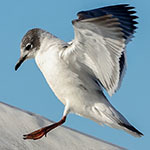 1/4 – Beacon, HRM 61: I got lucky this morning when a Franklin’s gull, previously spotted across the river by Ronnie DeLorenzo, decided to fly across and land at Beacon’s Waterfront Park. The Franklin’s gull, a first for Dutchess County, hung out for the day associating with ring-billed gulls on the riprap near the Beacon Ferry Terminal. Other gulls present included Iceland, glaucous, lesser black-backed, great black-backed, and Bonaparte’s. (Photo of Franklin's gull courtesy of Deborah Tracy Kral) 1/4 – Beacon, HRM 61: I got lucky this morning when a Franklin’s gull, previously spotted across the river by Ronnie DeLorenzo, decided to fly across and land at Beacon’s Waterfront Park. The Franklin’s gull, a first for Dutchess County, hung out for the day associating with ring-billed gulls on the riprap near the Beacon Ferry Terminal. Other gulls present included Iceland, glaucous, lesser black-backed, great black-backed, and Bonaparte’s. (Photo of Franklin's gull courtesy of Deborah Tracy Kral)
- Kyle Bardwell
Natural History Entries
12/18 – Hudson River Watershed: The Christmas Bird Count (CBC) is the nation’s longest running citizen-science effort and is held throughout the Americas at year’s end. This season’s suite of CBC’s is the 122nd.
The Christmas Bird Count replaced the Victorian era “side-shoot,” an event in which guests went out to shoot as many different bird and mammal species as one could on Christmas Day. In 1900, ornithologist Frank Chapman organized a group of friends to observe, count and share information about bird species without shooting them. That first year, 27 observers took part in the count in 25 places in the United States and Canada. The count totaled 18,500 individual birds belonging to 90 species. The National Audubon Society, which Chapman helped organize, now sponsors this annual tradition.
- Rich Guthrie
12/18 – Schenectady County, HRM 157: Nine field parties conducted our 91st annual Schenectady Christmas Bird Count documenting 61 species. Highlights included wood duck, gadwall, common goldeneye, hooded merganser, double-crested cormorant, eastern screech-owl, a great horned owl, yellow-bellied sapsucker, American kestrel, brown creeper, winter wren, golden-crowned kinglet, hermit thrush, gray catbird, swamp sparrow, red-winged blackbird, and brown-headed cowbird.
The three cormorants we counted represented a record with single individuals reported in just five counts prior to this one. We also topped the previous highs with 95 black vultures and 560 cedar waxwings.
- Larry Alden (Hudson-Mohawk Bird Club)
12/18 – Ulster County: The 72nd annual Ulster County Mohonk Lake/Ashokan Reservoir Audubon Christmas Bird Count was conducted under challenging weather conditions. A total of 54 participants (47 field observers and 7 feeder watchers) in 19 field parties encountered a total of 17,670 individual birds representing 83 species, plus five additional count week species. For historical context, diversity was five species above our ten-year average, and total abundance was up 3,865 individual birds. Our all-time high count for this count circle is 87 species and 22,307 individuals, both recorded in 2017.
Several field parties reported large flocks of American robins that were difficult to accurately count as they foraged on an exceptional abundance of berries. Our final conservative tally was 5,949 individuals, setting a new record high while greatly surpassing our previous high count of 3,504 in 2017.
New record high counts were also established for bufflehead (11, compared to 8 in 2018), yellow-bellied sapsucker (46, eclipsing 40 in 2017, 20 avg.), hermit thrush (16, eclipsing 13 in 2017), American pipit (138, greatly surpassing 41 in 2015), and yellow-rumped warbler (28, double our previous high count of 14 in 2017). Additional unusual species encountered during the count week period included a palm warbler (a first record for the historical count composite), and a golden eagle (previously one in 2017 and 1998).
- Steve M. Chorvas
12/18 – Putnam County, HRM 54: The forest of Fahnestock State Park was animated with black birds on this cold, damp day. A massive flock, easily more than a thousand strong, streamed along through the trees in the valley below me, stopping to flip leaves and probe for food. I could make out many common grackles, although the flock’s raucous clamor and constant motion made it difficult to tell if other ‘black birds’ were involved.
- Ed McGowan
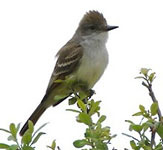 12/18 – Westchester County, HRM 30: We took a birding walk today in Rockwood Hall at the Rockefeller State Park Preserve. Among several sparrows was something different. Looking closer, we recognized it as an ash-throated flycatcher (Myiarchus cinerascens), a sighting verified by Sean Camillieri. This species is extremely rare in Westchester County being only the second record. They are found in the East only as very occasional accidentals, and even then, most sightings of this western flycatcher are more coastal. (Photo of ash-throated flycatcher courtesy of Larry Arbanas) 12/18 – Westchester County, HRM 30: We took a birding walk today in Rockwood Hall at the Rockefeller State Park Preserve. Among several sparrows was something different. Looking closer, we recognized it as an ash-throated flycatcher (Myiarchus cinerascens), a sighting verified by Sean Camillieri. This species is extremely rare in Westchester County being only the second record. They are found in the East only as very occasional accidentals, and even then, most sightings of this western flycatcher are more coastal. (Photo of ash-throated flycatcher courtesy of Larry Arbanas)
- Richard Leonard, Laura Rice
12/18 – Brooklyn, New York City: Our Christmas Bird Count is always a great deal of fun; this one was drizzly, but rather warm along the north shore of Jamaica Bay. Highlights were a pair of distant snowy owls, a peregrine falcon, several northern harriers, and a tutorial on sparrow identification from some genuine experts.
- Dave Taft
 12/19 – Saratoga Lake, HRM 182: At first light, the area was just coming out of a winter weather advisory that had left several inches of snow. Heavy gray clouds hung over the lake, and a stiff and frigid wind came from the west signaling the arrival of a cold front. But it was only a whisper of winter; we had yet to see our first true Arctic blast of heavy snow and ice. 12/19 – Saratoga Lake, HRM 182: At first light, the area was just coming out of a winter weather advisory that had left several inches of snow. Heavy gray clouds hung over the lake, and a stiff and frigid wind came from the west signaling the arrival of a cold front. But it was only a whisper of winter; we had yet to see our first true Arctic blast of heavy snow and ice.
There was a large raft of Canada geese far offshore from Brown’s Beach that tested the range of my scope. It was easy to give them a pass as “all-Canadas” except for the one obligatory snow goose I located. On the edge of the group was a single common loon as well. Inshore, there was a nice mix of puddle ducks and divers, including a male northern pintail, two black ducks, and mallards, as well as a dozen common goldeneyes and a similar number of ring-necked ducks, both hens and drakes.
While this early season visit had relatively meager returns on the water, the best sighting was in the air at the north end of the lake when a male northern harrier, “a gray ghost,” passed by. (Photo of northern harrier courtesy of John Badura)
- Tom Lake
[The male northern harrier, or marsh hawk, pale with black wing tips, is a light-colored raptor that birders often refer to as the “gray ghost.” Tom Lake]
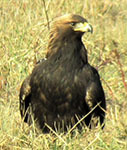 12/19 – Columbia County, HRM 128: Our southeastern portion of the Chatham Christmas Bird Count is bisected by the Taconic State Parkway which attracts golden eagles to road kill. I was very fortunate to get a photo today in a field just off the parkway during the Christmas Count week. So far, my best Christmas present! (Photo of golden eagle courtesy of Nancy Kern) 12/19 – Columbia County, HRM 128: Our southeastern portion of the Chatham Christmas Bird Count is bisected by the Taconic State Parkway which attracts golden eagles to road kill. I was very fortunate to get a photo today in a field just off the parkway during the Christmas Count week. So far, my best Christmas present! (Photo of golden eagle courtesy of Nancy Kern)
- Nancy Kern (Hudson-Mohawk Bird Club)
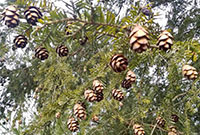 12/20 – Town of Wappinger, HRM 67: There is a small stand of eastern hemlock not far from the Hudson River that, in recent years, has been heavily infested with hemlock woolly adelgid (Adelges tsugae). We checked the trees today and found a large cone crop and almost no apparent evidence of the adelgid’s cottony egg masses. 12/20 – Town of Wappinger, HRM 67: There is a small stand of eastern hemlock not far from the Hudson River that, in recent years, has been heavily infested with hemlock woolly adelgid (Adelges tsugae). We checked the trees today and found a large cone crop and almost no apparent evidence of the adelgid’s cottony egg masses.
However, according to DEC Lands and Forests Research Scientist Jerry Carlson, the robust cone crop does not indicate healthy hemlocks. The color of the foliage was chlorotic (insufficient chlorophyll) and such robust cone crops, rather than indicting recovery, often result from stress. (Photo of Eastern hemlock courtesy of Tom Lake)
- Tom Lake, C.T. Lake
[The hemlock woolly adelgid, a small nonnative wingless insect (native to east Asia), was first reported in the eastern United States in 1951. Trees infected with this insect have white, cottony egg masses on their branches; they feed on the sap of hemlock branchlets resulting in the loss of their needles and inhibiting new growth. Restrictions on their range in our area appear limited to the severity of winters probably linked to elevation and latitude. We are hoping that the current hemlock woolly adelgid population will not cause "significant" mortality above 1,600 feet elevation and, at or below, 43 degrees latitude. This is a bio-geo-climatic effect where elevation, latitude, and "continental" condition may alter the threshold.
Hemlock woolly adelgid has an incredible capacity to adapt to new conditions. I have seen many stands that appear to recover from adelgid damage, especially following extreme low air temperature. Eventually, however, the adelgid comes back. If no predator or environmental extreme gets to them, they will inexorably feed on the trees until they kill them.
As a result, we think a “predator” solution is the best one to pursue. DEC is working very closely with Mark Whitmore at Cornell University who has established a substantial enterprise for finding and rearing adelgid predators, studying the insects, identifying the genome and improving ways to use DNA for diagnostics and detection. These are all tremendous assets, and we are optimistic their approach will keep hemlocks in our environment. Jerry Carlson]
[With warming winter temperatures (climate change) hemlock woolly adelgid will be able to expand its range in latitude and altitude. Hemlock woolly adelgid may also be adapting to colder areas much like its congener, the balsam woolly adelgid (A. piceae), has. Predators seem to be the driver of population control on the west coast so I’m hoping our introductions of the three most common species of obligate predators will be the long-term control in the east. Mark Whitmore]
For more information on hemlock woolly adelgid, visit the DEC website: https://www.dec.ny.gov/animals/7250.html
12/21 – Hudson River Watershed: The Winter Solstice arrived at 10:59 this morning. Sunset last night occurred at 4:31; sunrise this morning on the Solstice was 7:17, giving us 14 hours and 46 minutes of night. Sunset today was one minute later at 4:32, giving us 9 hours and 15 minutes of daylight—long night, short day.
- Tom Lake
[The Winter Solstice is the astronomical moment when the path of the Sun in the sky is angled farthest south (23.5 degrees south latitude) relative to the Northern Hemisphere. The Winter Solstice marks the beginning of slowly lengthening days and shortening nights. Tom Lake]
12/21 – Fort Edward, HRM 202: We checked the various areas of the Fort Edward Grasslands today and counted eleven northern harriers, a rough-legged hawk, an American kestrel, as well as several red-tailed hawks. While the strong and bitter wind made birding and photography challenging, and may have reduced the owl activity, we did see one short-eared owl.
- Scott Stoner, Denise Stoner (Hudson-Mohawk Bird Club)
12/21 – Saugerties, HRM 102: Just minutes before sunset on the winter solstice, our ‘resident’ harbor seal swam up to the north-side of the Saugerties Lighthouse. He approached, rolled, and splashed. After a few vocalizations, he submerged and disappeared. This was his Day 868.
- Patrick Landewe
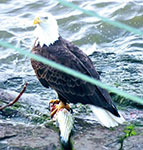 12/21 – Ossining, HRM 33: We glanced at the river today just in time to spot an adult bald eagle “swimming” a hundred feet offshore while attempting to fly. At first, we wondered if it was in trouble. Then we saw the eagle begin a butterfly stroke using its long wings as paddles. The bird made it to a big rock and hauled out grasping a large striped bass in its talons. The eagle made a few high-pitched calls and began picking at the fish with its beak. Another adult arrived, perhaps its mate, to share in the catch. (Photo of bald eagle courtesy of Nicki Turano) 12/21 – Ossining, HRM 33: We glanced at the river today just in time to spot an adult bald eagle “swimming” a hundred feet offshore while attempting to fly. At first, we wondered if it was in trouble. Then we saw the eagle begin a butterfly stroke using its long wings as paddles. The bird made it to a big rock and hauled out grasping a large striped bass in its talons. The eagle made a few high-pitched calls and began picking at the fish with its beak. Another adult arrived, perhaps its mate, to share in the catch. (Photo of bald eagle courtesy of Nicki Turano)
- Richard Leonard, Laura Rice
12/21 – Manhattan, New York City: The Randall's Island Park Alliance began a successful Christmas Bird Count with a peregrine falcon soaring overhead. Jacob Drucker led our count and got an early head start quickly spotting a ruddy turnstone and an Iceland gull. Our core group of seven birders counted 2,509 birds from 38 species (up from 25 in 2020) across Randall’s Island. Thanks to our expert birders, we did see a few that we might not have been able to identify. We saw no owls on our count, but there was photographic evidence of a snowy owl on Randall’s Island in early December.
- Jackie Wu
12/22 – Manhattan, HRM 2: In very cold and frigid winter winds, our Hudson River Park’s River Project staff checked our sampling and collection gear that we deploy off Pier 40 in Hudson River Park. Our expectations were limited, but we did capture a gorgeous young-of-year black sea bass (58 millimeters (mm)) as well as some sluggish grass shrimp (Palaemon sp.) and isopods.
- Siddhartha Hayes, Zoe Kim
[One inch = 25.4 millimeters (mm)]
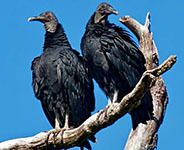 12/23 – Hudson, HRM 114: While driving into the city of Hudson this morning, we spotted 85 black vultures in an area where they often hang out on roof tops. A number of them had outstretched wings, soaking up warmth from the sun's rays and waiting for thermals that will lift them up and out of their night roost. (Photo of black vultures courtesy of Terry Hardy) 12/23 – Hudson, HRM 114: While driving into the city of Hudson this morning, we spotted 85 black vultures in an area where they often hang out on roof tops. A number of them had outstretched wings, soaking up warmth from the sun's rays and waiting for thermals that will lift them up and out of their night roost. (Photo of black vultures courtesy of Terry Hardy)
- Joan Scheu
 12/23 – Cold Spring, HRM 54: The Cold Spring Dock has always been a magnet for visitors, a spot from which they can view the majesty of the Hudson Highlands, from Crow’s Nest and Storm King upriver past Mount Taurus to Breakneck Ridge. The tide was rising, the current was rushing upriver, and a strong north wind was blowing down the six-mile reach from Bannerman’s Island to West Point—a classic wind-against tide. Turkey vultures in the Jetstream above the peaks were making their rounds with nary a wingbeat. Finally, a must-do of every visit to the dock was to take a timeout on a bench dedicated to the memory of Pete Seeger. (Photo of Pete Seeger plaque courtesy of Tom Lake) 12/23 – Cold Spring, HRM 54: The Cold Spring Dock has always been a magnet for visitors, a spot from which they can view the majesty of the Hudson Highlands, from Crow’s Nest and Storm King upriver past Mount Taurus to Breakneck Ridge. The tide was rising, the current was rushing upriver, and a strong north wind was blowing down the six-mile reach from Bannerman’s Island to West Point—a classic wind-against tide. Turkey vultures in the Jetstream above the peaks were making their rounds with nary a wingbeat. Finally, a must-do of every visit to the dock was to take a timeout on a bench dedicated to the memory of Pete Seeger. (Photo of Pete Seeger plaque courtesy of Tom Lake)
- Tom Lake, C.T. Lake
[The bench faces the river, nearest the rail, midway across. The plaque offers “In Memory of Pete Seeger.” Beneath the inscription are the dates 1943-2013. I have tried to discover the significance of those dates with no luck. Tom Lake]
12/24 – Washington County, HRM 209: While traveling home today near Hartford, I spotted a very “black-peppered” snowy owl flying over the road and heading northeast. The owl then perched in a tree, and I was able to pull over and get great scope views. It was really nice to see this species outside of the Washington County Grasslands area.
- Scott Varney (Hudson-Mohawk Bird Club)
12/24 – Brooklyn, New York City: It was Christmas Eve Day at Floyd Bennett Field, and the hollies were bursting with berries. Earlier, I got to watch several harriers and a kestrel working the grasslands management area. Looking out the window just now, I spotted a harrier wafting by buoyantly just yards away. I had a nice view of the white rump-patch on this immature bird. It must have been its way of wishing me a happy holiday season.
- Dave Taft
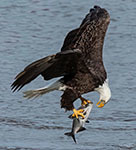 12/25 – Dutchess Cunty, HRM 68: Bald eagles stooping on gizzard shad are a winter tidewater ritual. Gizzard shad (Dorosoma cepedianum) are always a favorite of bald eagles, even more so in winter due to their availability stemming from their vulnerability. Gizzard shad frequently succumb to a phenomenon known as cold water “winter kill” in the northern extent of their range. Studies have shown (Jester and Jensen 1972) “... high mortality rates at water temperatures below 2.2 degrees Celsius” (35.96 Fahrenheit (F)). (Photo of bald eagle courtesy of Bob Rightmyer) 12/25 – Dutchess Cunty, HRM 68: Bald eagles stooping on gizzard shad are a winter tidewater ritual. Gizzard shad (Dorosoma cepedianum) are always a favorite of bald eagles, even more so in winter due to their availability stemming from their vulnerability. Gizzard shad frequently succumb to a phenomenon known as cold water “winter kill” in the northern extent of their range. Studies have shown (Jester and Jensen 1972) “... high mortality rates at water temperatures below 2.2 degrees Celsius” (35.96 Fahrenheit (F)). (Photo of bald eagle courtesy of Bob Rightmyer)
- Tom Lake
12/25 – Manhattan, HRM 2: Autumn had turned to winter. The aquatic creatures in the Hudson River Park’s River Project sampling and collection gear that they deploy off Pier 40 was diminishing in both numbers and diversity. However, two aquatic invertebrates, a mix of colonial hydroids and bushy/branching colonies of bryozoans, were growing and collecting like weeds on their gear. To many of us, these are extremely complex and nearly unknowable life forms. Our expert on them is Toland Kister, who will present each group beginning with the colonial hydroids.
- Tom Lake
Colonial hydroids are aquatic animals belonging to the taxonomic class Hydrozoa within the subphylum Cnidaria (alongside jellyfish and corals). Individually, they are very small, predatory animals. Like coral, colonial hydroid colonies are made up of polyps. In solitary hydra, the original polyp produces buds that eventually separate and grow as new individuals. In colonial hydroids, these buds remain attached to the original polyp. As subsequent polyps continue to bud, a branching structure occurs. Individual hydroid polyps, also called zooids, take on specialized roles within the colony.
Gastrozooids, which tend to be the most common, are feeding polyps. They possess tentacles bearing nematocysts (stinging cells) that help to stun prey surrounding a mouth that they use to ingest food. Because individual zooids in a colony are all connected by a tube called a stolon, they are able to exchange food between individuals to support the colony.
Gonozooids are reproductive structures, lacking the tentacles of their gastrozooid neighbors. While these are the two primary zooids, many colonial hydroid species possess zooids that are even more specialized for colony defense and other purposes. Colonial hydroids feed on a wide variety of items from plankton to fish and other animals drifting in the water.
- Toland Kister
12/26 – Saratoga Lake, HRM 182: I drove up the east side of Saratoga Lake beginning at Brown's Beach where I saw the first sizeable raft of ring-necked ducks as well as larger rafts farther offshore.
Moving along, I spotted more than 200 greater and lesser scaup, at least 220 ring-necked ducks, scattered hooded mergansers, common mergansers, and a couple of gadwalls, black ducks, buffleheads and common goldeneyes. Later, reviewing my photos, I picked up a drake redhead duck and a pair of white-winged scoters. Saratoga Lake is not birder-friendly most of the way around, which is frustrating because the lake is such an important spot for waterfowl to rest and feed before heading on.
- Ron Harrower (Hudson-Mohawk Bird Club)
 12/26 – Little Stony Point, HRM 55: We walked the beach on the south side in the lee of the point sheltered from a frigid northwest wind. Much of the beach contained evidence of ice and tidal erosion and was dominated by light-colored granitic gravel, remnants of the early 20th century mining of Mount Taurus. Lying in the tide line, looking out of place, was a dark gray stone that had eroded from the river bank. A close inspection revealed that it was an artifact, a stone that had been altered by human hands. (Photo of Indian artifact courtesy of Tom Lake) 12/26 – Little Stony Point, HRM 55: We walked the beach on the south side in the lee of the point sheltered from a frigid northwest wind. Much of the beach contained evidence of ice and tidal erosion and was dominated by light-colored granitic gravel, remnants of the early 20th century mining of Mount Taurus. Lying in the tide line, looking out of place, was a dark gray stone that had eroded from the river bank. A close inspection revealed that it was an artifact, a stone that had been altered by human hands. (Photo of Indian artifact courtesy of Tom Lake)
- Christopher T. Lake
[Christopher had walked into the world of archaeology coming upon a water-worn but still identifiable artifact (79 x 28 mm) that appeared to be a prehistoric utilitarian stone tool fashioned from dark gray chert, a hard sedimentary rock. Applying a principle of design—form follows function—we concluded that it was a hide scraper or a knife. One side had been ground to a sharp edge, the other was “backed” or dulled to fit a hand comfortably. Stone tools used for long-term, repetitive tasks, were fashioned for comfort. With the tool in hand, its contours suggested “handedness,” fitting much better in a right, rather than a left hand.
While such stone artifacts cannot be precisely dated outside of their original context, we could envision an indigenous Mohican filleting a white perch on this beach more than a thousand years ago. I thought of William Faulkner’s words, “The past is not dead. It even isn’t past.” The past is always with us. Tom Lake]
12/27 – Town of Warwick, HRM 41: The hundred-acre t-shaped wetland pond at Liberty Marsh was filled to capacity with Canada geese. New flocks flying in veered off and headed toward the Wallkill River a quarter mile off. The 335-acre Liberty Marsh is part of the U.S. Fish and Wildlife Service’s Wallkill River National Wildlife Refuge Complex, adjacent to and near the headwaters of the Wallkill River.
As beads of ice mixed with flurries, we walked the Liberty Loop Trail to the unrelenting cacophony of goose calls. At one point, we heard a common loon. After a pause, we heard it again, very distinctive within the monotones of the geese. In early afternoon the goose chatter markedly increased. Then, like a signal had been passed, the pond began to empty. The geese left in contingents, a platoon at a time, into the wind, until the pond was empty, and a thousand geese were in the air headed north to an expanse of cornfields.
- Tom Lake, C.T Lake
12/27 – Croton-on-Hudson, HRM 34: It was high tide in late afternoon at the mouth of the Croton River. In a backwater marsh just inside the railroad trestle, I saw a seal chasing what appeared to be some large fish, perhaps striped bass or gizzard shad. After a few jumps I knew it was a harbor seal. (Note: a second harbor seal was, at the time, 68 miles upriver at Saugerties.)
- Asher Fried
*** Fish of the Week***
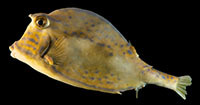 12/27 – Hudson River Watershed: Fish-of-the-Week for Weeks 152-154 is the scrawled cowfish (Acanthostracion quadricornis), number 233 (of 236) on our watershed list of fishes. If you would like a copy of our list, e-mail: trlake7@aol.com. 12/27 – Hudson River Watershed: Fish-of-the-Week for Weeks 152-154 is the scrawled cowfish (Acanthostracion quadricornis), number 233 (of 236) on our watershed list of fishes. If you would like a copy of our list, e-mail: trlake7@aol.com.
The scrawled cowfish is the sole member of its family, the boxfishes (Ostraciidae), in our watershed and are considered a temperate marine stray. They range along the eastern Atlantic from Massachusetts to the Gulf of Mexico but are far more common in the warmer, southerly waters of their range. The boxfishes are a slow-moving bottom dweller easily recognizable by their bony armor of closely-fitted plates that cover most of their body. Adults can reach 19-inches in length.
The scrawled cowfish is on our watershed list of fishes from a single occurrence on August 1, 2001. This was a juvenile (19 mm) captured by Cathy Drew in a small mesh minnow trap at Pier 26 in Manhattan. The tiny fish was the size and shape of a small pea.
Bob Schmidt identified the scrawled cowfish as a new species for the Hudson River watershed. After some further analysis, it became obvious to us that this was also an undescribed life stage and was later published.
- Schmidt, Robert E., and Thomas R. Lake
2001 A benthic juvenile scrawled cowfish (Acanthostracion quadricornis) from the lower Hudson River Estuary. Northeastern Naturalist 8(3):343-346. (Photo of scrawled cowfish courtesy of Joel Sartore)
- Tom Lake
12/28 – Town of Wappinger, HRM 67: Three weeks ago, we collected a woolly bear caterpillar, the larval form of the Isabella tiger moth (Pyrrharctia isabella), for analysis. We made our measurements in the spirit of the old, but perhaps not entirely discredited, belief (folklore) that the width of their three rings—fore-to-aft, black-brown-black—can predict winter’s severity. The theory states that the broader the middle brown section, the milder the coming winter will be.
The initial woolly bear (33 mm) was dominated by its middle brown section at 42% of its total length. Today, we collected another woolly bear (35 mm) and conducted our analysis. The second woolly bear made an even bolder prediction of a mild winter as its middle brown section was 64% of its total length.
- Tom Lake, C.T. Lake
12/29 – Ulster-Dutchess counties: The eleventh annual Ulster/Dutchess (NYUD) Christmas Bird Count was conducted today. Forty-three birders in 21 field parties contributed to the ten sectors of the circle that included parts Ulster, Dutchess, Columbia, and a tiny slice of Greene County.
Eighty-four species were identified this year on count day, which was precisely the yearly average in our count’s first ten years. Two new species, a northern shrike and an eastern meadowlark, were added to the composite list that now stands at 131 species. Also, a marsh wren added to our composite list last year was again seen this year.
Noteworthy about this year’s count was the ongoing trend of extraordinary numbers of American robins in our region into early winter. A bumper crop of juniper (eastern red cedar) cones surely fueled this phenomenon. A spectacular (and conservative) total of 8,562 individual robins from just one field party alone helped to illustrate this massive incursion. Cedar waxwing, eastern bluebird, hermit thrush, and yellow-rumped warbler were also were counted in exceptional and, in some cases, record numbers. As a result, 32,334 birds were tallied setting a new high of individuals easily eclipsing our previous record of 26,034 in 2011 and nearly doubling the average per count of 16,922.
- Mark DeDea
12/29 –- Beacon, HRM 61: It was more than a week into winter and we still had the urge to wet a net. The air was just above freezing, and the river had dropped to 39 degrees F. It was a fool’s errand for sure, but we set our 30-footer in the surf at Long Dock and hoped no one saw us. However, it was not long before three dog-walkers inquired as to what “we were after.” A serious head cold, or worse, would have been a good answer but we just shrugged. By the sixth haul, our hands were red and numb, but we saw a tiny twitch in the bag of the seine. It was a single, beautiful, native spottail shiner, made even more so by the circumstances. We gathered our gear and ambled off the beach as “accomplished” fishermen.
- Tom Lake, C.T. Lake
12/30 – Manhattan, HRM 2: Our Hudson River Park’s River Project staff checked our sampling and collection gear that we deploy off Pier 40 in Hudson River Park for the last time in 2021. Our traps and pots were empty today, a reflection of the late season and cooling river. However, we were happy to conclude another successful year of our Fish Ecology Survey and were looking forward to returning next week to start collecting data for 2022.
-Toland Kister, Anna Koskol
12/31 – Manhattan, HRM 2: This is Part 2 of Toland Kister’s presentation on aquatic invertebrates that have been growing and collecting like weeds on the Hudson River Park’s River Project sampling and collection gear that they deploy off Pier 40. Today, Toland presents bryozoans.
- Tom Lake
Bryozoans are microscopic, aquatic, colonial invertebrates within the phylum Bryozoa. While they occupy a relatively similar niche to colonial hydroids, there are some key differences. Bryozoans are filter feeders usually living in sedentary colonies. Similar to hydroids, a bryozoan colony begins its life with a founding, or original, zooid settling down from its free-swimming larval state. Individual bryozoan zooids are made up of a cystic (body wall and exoskeleton) and the zooid (digestive and nervous system, muscles, feeding structure and other specialized structure).
To grow the colony, the original zooid buds off clones that can form feeding zooids, defensive zooids, and reproductive zooids. Similar to hydroids, bryozoan colonies are capable of sharing nutrients between zooids. While bryozoan feeding structures may look similar to hydroids (both organisms feature a crown of tentacles), they have a different method of food capture. Bryozoans primarily feed on plankton and bacteria that they pull to their mouths using cilia lined up and down their tentacles. These cilia, or small, hair-like structures, move in tandem with each other to create a current that draws food particles toward the bryozoan's mouth where it can be ingested.
- Toland Kister
1/1 – Delmar, HRM 143: Our annual New Year's Day bird species count was held at Five Rivers Environmental Education Center this morning. The highlight was a veery (Catharus fuscescens), spotted by Naomi Lloyd and the group she was leading. The only previous January record of veery in New York was a single bird in Manhattan (NYC) for a couple of weeks in 2020. Almost all veeries are in South or Central America in January. Other sightings were unremarkable by comparison.
- John Kent (Hudson-Mohawk Bird Club)
[The veery is a small North American thrush species, a member of a group of closely related and similar species in the genus Catharus that also includes the gray-cheeked thrush (C. minimus), Bicknell's thrush (C. bicknelli), Swainson's thrush (C. ustulatus), and hermit thrush (C. guttatus). (P. Clement 2001)]
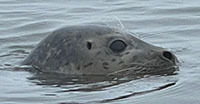 1/1 - Saugerties Lighthouse, HRM 102: Yesterday, upon our return from holiday travel, we were greeted by the male harbor seal, flipper-tagged 246. He was photographed swimming in the north cove and in the mouth of Esopus Creek around sunset. Earlier on this New Year’s Day afternoon, the seal appeared again while following kayaker Paul Andreassen as he paddled around the lighthouse. This was the seal’s Day 878. (Photo of harbor seal courtesy of Paul Andressan) 1/1 - Saugerties Lighthouse, HRM 102: Yesterday, upon our return from holiday travel, we were greeted by the male harbor seal, flipper-tagged 246. He was photographed swimming in the north cove and in the mouth of Esopus Creek around sunset. Earlier on this New Year’s Day afternoon, the seal appeared again while following kayaker Paul Andreassen as he paddled around the lighthouse. This was the seal’s Day 878. (Photo of harbor seal courtesy of Paul Andressan)
- Patrick Landewe
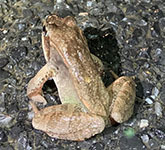 1/1 – Town of Esopus: We came upon a wood frog (Lithobates sylvaticus) beside a trail we were walking in the Town of Esopus. That seemed out of place, but then the air was 52 degrees F, and a hatch of insects was buzzing among the grasses along the trail. Is this to be the new normal? 1/1 – Town of Esopus: We came upon a wood frog (Lithobates sylvaticus) beside a trail we were walking in the Town of Esopus. That seemed out of place, but then the air was 52 degrees F, and a hatch of insects was buzzing among the grasses along the trail. Is this to be the new normal?
It was remarkable that while many species burrow to seek warmth while hibernating, the wood frog chooses to stay at the surface and freeze solid. Over half of the water in the frog’s body turns to ice turning the body and limbs ridged. Meanwhile compounds that act as “antifreeze” keep the cells functioning until spring. In the weeks ahead, these adaptations will no doubt come into play. Meanwhile, this fellow was enjoying a New Year’s stroll. (Photo of wood frog courtesy of Laura Heady)
- Mario Meier, Robin Meier
 1/2 – Troy, HRM 153: We counted 46 species in our sector of the Troy Christmas Bird Count. “Good” birds included northern harriers, yellow-bellied sapsucker, peregrine falcon, and snow bunting. However, our best bird by far was a northern shrike in a pasture in the Town of Schaghticoke. (Photo of northern shrike courtesy of Jim Yates) 1/2 – Troy, HRM 153: We counted 46 species in our sector of the Troy Christmas Bird Count. “Good” birds included northern harriers, yellow-bellied sapsucker, peregrine falcon, and snow bunting. However, our best bird by far was a northern shrike in a pasture in the Town of Schaghticoke. (Photo of northern shrike courtesy of Jim Yates)
- Larry Alden, Penny Alden (Hudson-Mohawk Bird Club)
[The northern shrike (Lanius excubitor) is a boreal songbird whose presence in the Hudson Valley is often associated with severe winter weather to the north. They are often in migration from near-Arctic breeding grounds to Mid-Atlantic wintering sites. They have a raptor-like appearance and will often impale their prey (smaller songbirds) on thorns or barbed wire. This has earned them the scientific name for their genus, Lanius, Latin for butcher. Tom Lake]
1/2 – Saugerties, HRM 102: Early this morning, our harbor seal was swimming just south of channel marker #93 at the mouth of Esopus Creek. This was the seal’s Day 879.
- Patrick Landewe
1/3 – Saratoga Lake, HRM 182: After a long stretch of relatively warm weather, the air was 19 degrees F this morning and it felt like the tundra. The lake was 98% open but likely to freeze-over soon. Saratoga Lake is a big-time stopover for many waterfowl species. The 29 species counted today included all the waterfowl seen a week ago. Raptors included an adult bald eagle and an American kestrel that landed in a tree at Waterfront Park.
- Ron Harrower (Hudson-Mohawk Bird Club)
1/4 – Troy, HRM 153: The updated species total for the Troy CBC now stands at 64, up from 46 two days ago. Additions to our “good bird” list now include snow geese, wood duck, ring-necked duck, common loon, American kestrel, red-breasted nuthatch, winter wren, and a swamp sparrow. There were no “winter finches” or white-winged gulls.
- Larry Alden (Hudson-Mohawk Bird Club)
1/4 – Ulster County, HRM 87: The air was a chilly 28 degrees F in High Falls this evening as we headed down our road. In our headlights we saw what appeared to be our Labrador retriever, having escaped again, and wandering the road. I lowered our headlights and we realized that it was a young black bear. Both of us regained our senses as it scampered beyond a slight curve in the road and into the forest. It was a birthday surprise for me.
- Sue Horowitz, Woody Horowitz
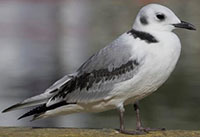 1/4 – Beacon, HRM 61: After getting a good look at the Dutchess County’s first Franklin’s gull at the Beacon Waterfront Park, I hung around for a while. While scanning the river, I picked up what I initially thought was a Bonaparte's Gull. After closer examination, however, as the bird drifted a little closer, I noticed a dark black collar at the base of the neck, dark bill, and a large smudge behind the eye. It was an immature, first-winter black-legged kittiwake, only the fifth occurrence of the species recorded for Dutchess County. The bird eventually took off, and the dark "M" pattern on the back, white window panes, clean underwing and black tail tip were all noted. (Photo of black-legged kittiwake courtesy of Cornell Lab of Orinthology) 1/4 – Beacon, HRM 61: After getting a good look at the Dutchess County’s first Franklin’s gull at the Beacon Waterfront Park, I hung around for a while. While scanning the river, I picked up what I initially thought was a Bonaparte's Gull. After closer examination, however, as the bird drifted a little closer, I noticed a dark black collar at the base of the neck, dark bill, and a large smudge behind the eye. It was an immature, first-winter black-legged kittiwake, only the fifth occurrence of the species recorded for Dutchess County. The bird eventually took off, and the dark "M" pattern on the back, white window panes, clean underwing and black tail tip were all noted. (Photo of black-legged kittiwake courtesy of Cornell Lab of Orinthology)
- Sean Camillieri
1/5 – Saugerties, HRM 102: Early this morning, a flock of common mergansers swam and fished in the mouth of the Esopus Creek watched over by six immature bald eagles perched in treetops nearby.
- Patrick Landewe
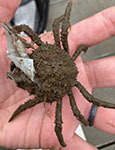 1/5 – Manhattan, HRM 2: Hudson River Park’s River Project staff checked our sampling and collection gear that we deploy off Pier 40 in Hudson River Park. There were no fish in the pots and traps, but there was a spider crab using a piece of duct tape to decorate its shell! (Photo of common spider crab courtesy of Natale Kim) 1/5 – Manhattan, HRM 2: Hudson River Park’s River Project staff checked our sampling and collection gear that we deploy off Pier 40 in Hudson River Park. There were no fish in the pots and traps, but there was a spider crab using a piece of duct tape to decorate its shell! (Photo of common spider crab courtesy of Natale Kim)
- Natalie Kim, Toland Kister, Siddhartha Hayes
[The common spider crab (Libinia emarginata) is a small (100 mm), slow-moving native decapod, that ranges from the Canadian Maritimes to the Gulf of Mexico. Like other “decorator crabs,” spider crabs cover their carapace with debris as a means of camouflage. Tom Lake]
1/6 – Saugerties, HRM 102: Early this morning, showing no ill effects from the onset of real winter, our harbor seal was again seen swimming just south of channel marker #93 at the mouth of Esopus Creek. This was the seal’s Day 883.
- Patrick Landewe
1/6 – Hudson River mile 67: Without even being there to see it happening, it had become obvious that water bodies upstream in the watershed were beginning to freeze-over. Large numbers of waterfowl that require open water were arriving in tidewater including rafts of common mergansers, ring-necked ducks, buffleheads, common goldeneyes, and various scaup.
- Tom Lake
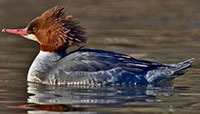 1/7 – Wappinger Creek, HRM 67: This was Day 2 of an immense influx (arrival) of migrating waterfowl. Today’s feature across nearly a mile of tidewater Wappinger Creek was more than a hundred common merganser with equal numbers of hens and drakes. 1/7 – Wappinger Creek, HRM 67: This was Day 2 of an immense influx (arrival) of migrating waterfowl. Today’s feature across nearly a mile of tidewater Wappinger Creek was more than a hundred common merganser with equal numbers of hens and drakes.
While the drake common merganser is one of the most beautiful of diving ducks, the hen common merganser is also very attractive. With her fly-away red-feathered head, she always reminds me of Elsa Lanchester in the 1935 movie of Mary Shelley’s “Bride of Frankenstein.” (Photo of common merganser courtesy of Jan Nagalski)
- Tom Lake
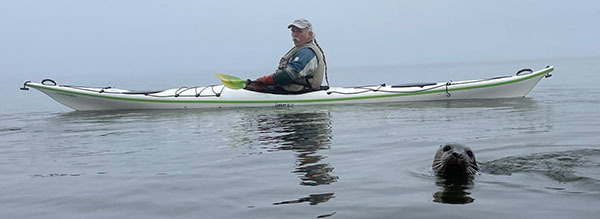
Winter 2021 Natural History Programs and Events
Plants and Animals of Conservation Concern: An Introduction to New York State Species Designations Thursday, January 20, 2022, 12:30-2:00 PM
(Register here)
What does it mean when a species is formally listed as endangered, threatened, special concern, or rare? And how do these legal ranks relate to the species of greatest conservation need list or the conservation status determined by the New York Natural Heritage Program? This webinar will provide an introduction to the different designations for plant and animal species in New York State, how they relate to regulatory protections, and how they are addressed in reviewing proposed projects.
Presenters:
Dr. Dan Rosenblatt, Wildlife Diversity Section Head, DEC Division of Fish and Wildlife
Nick Conrad, Information Resources Coordinator, New York Natural Heritage Program
Hudson River Miles
The Hudson is measured north from Hudson River Mile 0 at the Battery at the southern tip of Manhattan. The George Washington Bridge is at HRM 12, the Tappan Zee 28, Bear Mountain 47, Beacon-Newburgh 62, Mid-Hudson 75, Kingston-Rhinecliff 95, Rip Van Winkle 114, and the Federal Dam at Troy, the head of tidewater, at 153. The tidal section of the Hudson constitutes a bit less than half the total distance – 315 miles – from Lake Tear of the Clouds to the Battery. Entries from points east and west in the watershed reference the corresponding river mile on the mainstem.
To Contribute Your Observations or to Subscribe
The Hudson River Almanac is compiled and edited by Tom Lake and emailed weekly by DEC's Hudson River Estuary Program. Share your observations by e-mailing them to trlake7@aol.com. To subscribe to the Almanac (or to unsubscribe), use the links on DEC's Hudson River Almanac or DEC Delivers web pages.
Useful Links
National Oceanic and Atmospheric Administration online tide and tidal current predictions are invaluable when planning Hudson River field trips. For real-time information on Hudson River tides, weather and water conditions from sixteen monitoring stations, visit the Hudson River Environmental Conditions Observing System website.
DEC's Smartphone app for iPhone and Android is now available at: New York Fishing, Hunting & Wildlife App.
|


 1/4 – Beacon, HRM 61: I got lucky this morning when a Franklin’s gull, previously spotted across the river by Ronnie DeLorenzo, decided to fly across and land at Beacon’s Waterfront Park. The Franklin’s gull, a first for Dutchess County, hung out for the day associating with ring-billed gulls on the riprap near the Beacon Ferry Terminal. Other gulls present included Iceland, glaucous, lesser black-backed, great black-backed, and Bonaparte’s. (Photo of Franklin's gull courtesy of Deborah Tracy Kral)
1/4 – Beacon, HRM 61: I got lucky this morning when a Franklin’s gull, previously spotted across the river by Ronnie DeLorenzo, decided to fly across and land at Beacon’s Waterfront Park. The Franklin’s gull, a first for Dutchess County, hung out for the day associating with ring-billed gulls on the riprap near the Beacon Ferry Terminal. Other gulls present included Iceland, glaucous, lesser black-backed, great black-backed, and Bonaparte’s. (Photo of Franklin's gull courtesy of Deborah Tracy Kral) 12/18 – Westchester County, HRM 30: We took a birding walk today in Rockwood Hall at the Rockefeller State Park Preserve. Among several sparrows was something different. Looking closer, we recognized it as an ash-throated flycatcher (Myiarchus cinerascens), a sighting verified by Sean Camillieri. This species is extremely rare in Westchester County being only the second record. They are found in the East only as very occasional accidentals, and even then, most sightings of this western flycatcher are more coastal. (Photo of ash-throated flycatcher courtesy of Larry Arbanas)
12/18 – Westchester County, HRM 30: We took a birding walk today in Rockwood Hall at the Rockefeller State Park Preserve. Among several sparrows was something different. Looking closer, we recognized it as an ash-throated flycatcher (Myiarchus cinerascens), a sighting verified by Sean Camillieri. This species is extremely rare in Westchester County being only the second record. They are found in the East only as very occasional accidentals, and even then, most sightings of this western flycatcher are more coastal. (Photo of ash-throated flycatcher courtesy of Larry Arbanas) 12/19 – Saratoga Lake, HRM 182: At first light, the area was just coming out of a winter weather advisory that had left several inches of snow. Heavy gray clouds hung over the lake, and a stiff and frigid wind came from the west signaling the arrival of a cold front. But it was only a whisper of winter; we had yet to see our first true Arctic blast of heavy snow and ice.
12/19 – Saratoga Lake, HRM 182: At first light, the area was just coming out of a winter weather advisory that had left several inches of snow. Heavy gray clouds hung over the lake, and a stiff and frigid wind came from the west signaling the arrival of a cold front. But it was only a whisper of winter; we had yet to see our first true Arctic blast of heavy snow and ice.  12/19 – Columbia County, HRM 128: Our southeastern portion of the Chatham Christmas Bird Count is bisected by the Taconic State Parkway which attracts golden eagles to road kill. I was very fortunate to get a photo today in a field just off the parkway during the Christmas Count week. So far, my best Christmas present! (Photo of golden eagle courtesy of Nancy Kern)
12/19 – Columbia County, HRM 128: Our southeastern portion of the Chatham Christmas Bird Count is bisected by the Taconic State Parkway which attracts golden eagles to road kill. I was very fortunate to get a photo today in a field just off the parkway during the Christmas Count week. So far, my best Christmas present! (Photo of golden eagle courtesy of Nancy Kern) 12/20 – Town of Wappinger, HRM 67: There is a small stand of eastern hemlock not far from the Hudson River that, in recent years, has been heavily infested with hemlock woolly adelgid (Adelges tsugae). We checked the trees today and found a large cone crop and almost no apparent evidence of the adelgid’s cottony egg masses.
12/20 – Town of Wappinger, HRM 67: There is a small stand of eastern hemlock not far from the Hudson River that, in recent years, has been heavily infested with hemlock woolly adelgid (Adelges tsugae). We checked the trees today and found a large cone crop and almost no apparent evidence of the adelgid’s cottony egg masses.  12/21 – Ossining, HRM 33: We glanced at the river today just in time to spot an adult bald eagle “swimming” a hundred feet offshore while attempting to fly. At first, we wondered if it was in trouble. Then we saw the eagle begin a butterfly stroke using its long wings as paddles. The bird made it to a big rock and hauled out grasping a large striped bass in its talons. The eagle made a few high-pitched calls and began picking at the fish with its beak. Another adult arrived, perhaps its mate, to share in the catch. (Photo of bald eagle courtesy of Nicki Turano)
12/21 – Ossining, HRM 33: We glanced at the river today just in time to spot an adult bald eagle “swimming” a hundred feet offshore while attempting to fly. At first, we wondered if it was in trouble. Then we saw the eagle begin a butterfly stroke using its long wings as paddles. The bird made it to a big rock and hauled out grasping a large striped bass in its talons. The eagle made a few high-pitched calls and began picking at the fish with its beak. Another adult arrived, perhaps its mate, to share in the catch. (Photo of bald eagle courtesy of Nicki Turano) 12/23 – Hudson, HRM 114: While driving into the city of Hudson this morning, we spotted 85 black vultures in an area where they often hang out on roof tops. A number of them had outstretched wings, soaking up warmth from the sun's rays and waiting for thermals that will lift them up and out of their night roost. (Photo of black vultures courtesy of Terry Hardy)
12/23 – Hudson, HRM 114: While driving into the city of Hudson this morning, we spotted 85 black vultures in an area where they often hang out on roof tops. A number of them had outstretched wings, soaking up warmth from the sun's rays and waiting for thermals that will lift them up and out of their night roost. (Photo of black vultures courtesy of Terry Hardy) 12/23 – Cold Spring, HRM 54: The Cold Spring Dock has always been a magnet for visitors, a spot from which they can view the majesty of the Hudson Highlands, from Crow’s Nest and Storm King upriver past Mount Taurus to Breakneck Ridge. The tide was rising, the current was rushing upriver, and a strong north wind was blowing down the six-mile reach from Bannerman’s Island to West Point—a classic wind-against tide. Turkey vultures in the Jetstream above the peaks were making their rounds with nary a wingbeat. Finally, a must-do of every visit to the dock was to take a timeout on a bench dedicated to the memory of Pete Seeger. (Photo of Pete Seeger plaque courtesy of Tom Lake)
12/23 – Cold Spring, HRM 54: The Cold Spring Dock has always been a magnet for visitors, a spot from which they can view the majesty of the Hudson Highlands, from Crow’s Nest and Storm King upriver past Mount Taurus to Breakneck Ridge. The tide was rising, the current was rushing upriver, and a strong north wind was blowing down the six-mile reach from Bannerman’s Island to West Point—a classic wind-against tide. Turkey vultures in the Jetstream above the peaks were making their rounds with nary a wingbeat. Finally, a must-do of every visit to the dock was to take a timeout on a bench dedicated to the memory of Pete Seeger. (Photo of Pete Seeger plaque courtesy of Tom Lake) 12/25 – Dutchess Cunty, HRM 68: Bald eagles stooping on gizzard shad are a winter tidewater ritual. Gizzard shad (Dorosoma cepedianum) are always a favorite of bald eagles, even more so in winter due to their availability stemming from their vulnerability. Gizzard shad frequently succumb to a phenomenon known as cold water “winter kill” in the northern extent of their range. Studies have shown (Jester and Jensen 1972) “... high mortality rates at water temperatures below 2.2 degrees Celsius” (35.96 Fahrenheit (F)). (Photo of bald eagle courtesy of Bob Rightmyer)
12/25 – Dutchess Cunty, HRM 68: Bald eagles stooping on gizzard shad are a winter tidewater ritual. Gizzard shad (Dorosoma cepedianum) are always a favorite of bald eagles, even more so in winter due to their availability stemming from their vulnerability. Gizzard shad frequently succumb to a phenomenon known as cold water “winter kill” in the northern extent of their range. Studies have shown (Jester and Jensen 1972) “... high mortality rates at water temperatures below 2.2 degrees Celsius” (35.96 Fahrenheit (F)). (Photo of bald eagle courtesy of Bob Rightmyer) 12/26 – Little Stony Point, HRM 55: We walked the beach on the south side in the lee of the point sheltered from a frigid northwest wind. Much of the beach contained evidence of ice and tidal erosion and was dominated by light-colored granitic gravel, remnants of the early 20th century mining of Mount Taurus. Lying in the tide line, looking out of place, was a dark gray stone that had eroded from the river bank. A close inspection revealed that it was an artifact, a stone that had been altered by human hands. (Photo of Indian artifact courtesy of Tom Lake)
12/26 – Little Stony Point, HRM 55: We walked the beach on the south side in the lee of the point sheltered from a frigid northwest wind. Much of the beach contained evidence of ice and tidal erosion and was dominated by light-colored granitic gravel, remnants of the early 20th century mining of Mount Taurus. Lying in the tide line, looking out of place, was a dark gray stone that had eroded from the river bank. A close inspection revealed that it was an artifact, a stone that had been altered by human hands. (Photo of Indian artifact courtesy of Tom Lake) 12/27 – Hudson River Watershed: Fish-of-the-Week for Weeks 152-154 is the scrawled cowfish (Acanthostracion quadricornis), number 233 (of 236) on our watershed list of fishes. If you would like a copy of our list, e-mail:
12/27 – Hudson River Watershed: Fish-of-the-Week for Weeks 152-154 is the scrawled cowfish (Acanthostracion quadricornis), number 233 (of 236) on our watershed list of fishes. If you would like a copy of our list, e-mail:  1/1 - Saugerties Lighthouse, HRM 102: Yesterday, upon our return from holiday travel, we were greeted by the male harbor seal, flipper-tagged 246. He was photographed swimming in the north cove and in the mouth of Esopus Creek around sunset. Earlier on this New Year’s Day afternoon, the seal appeared again while following kayaker Paul Andreassen as he paddled around the lighthouse. This was the seal’s Day 878. (Photo of harbor seal courtesy of Paul Andressan)
1/1 - Saugerties Lighthouse, HRM 102: Yesterday, upon our return from holiday travel, we were greeted by the male harbor seal, flipper-tagged 246. He was photographed swimming in the north cove and in the mouth of Esopus Creek around sunset. Earlier on this New Year’s Day afternoon, the seal appeared again while following kayaker Paul Andreassen as he paddled around the lighthouse. This was the seal’s Day 878. (Photo of harbor seal courtesy of Paul Andressan) 1/1 – Town of Esopus: We came upon a wood frog (Lithobates sylvaticus) beside a trail we were walking in the Town of Esopus. That seemed out of place, but then the air was 52 degrees F, and a hatch of insects was buzzing among the grasses along the trail. Is this to be the new normal?
1/1 – Town of Esopus: We came upon a wood frog (Lithobates sylvaticus) beside a trail we were walking in the Town of Esopus. That seemed out of place, but then the air was 52 degrees F, and a hatch of insects was buzzing among the grasses along the trail. Is this to be the new normal?  1/2 – Troy, HRM 153: We counted 46 species in our sector of the Troy Christmas Bird Count. “Good” birds included northern harriers, yellow-bellied sapsucker, peregrine falcon, and snow bunting. However, our best bird by far was a northern shrike in a pasture in the Town of Schaghticoke. (Photo of northern shrike courtesy of Jim Yates)
1/2 – Troy, HRM 153: We counted 46 species in our sector of the Troy Christmas Bird Count. “Good” birds included northern harriers, yellow-bellied sapsucker, peregrine falcon, and snow bunting. However, our best bird by far was a northern shrike in a pasture in the Town of Schaghticoke. (Photo of northern shrike courtesy of Jim Yates) 1/4 – Beacon, HRM 61: After getting a good look at the Dutchess County’s first Franklin’s gull at the Beacon Waterfront Park, I hung around for a while. While scanning the river, I picked up what I initially thought was a Bonaparte's Gull. After closer examination, however, as the bird drifted a little closer, I noticed a dark black collar at the base of the neck, dark bill, and a large smudge behind the eye. It was an immature, first-winter black-legged kittiwake, only the fifth occurrence of the species recorded for Dutchess County. The bird eventually took off, and the dark "M" pattern on the back, white window panes, clean underwing and black tail tip were all noted. (Photo of black-legged kittiwake courtesy of Cornell Lab of Orinthology)
1/4 – Beacon, HRM 61: After getting a good look at the Dutchess County’s first Franklin’s gull at the Beacon Waterfront Park, I hung around for a while. While scanning the river, I picked up what I initially thought was a Bonaparte's Gull. After closer examination, however, as the bird drifted a little closer, I noticed a dark black collar at the base of the neck, dark bill, and a large smudge behind the eye. It was an immature, first-winter black-legged kittiwake, only the fifth occurrence of the species recorded for Dutchess County. The bird eventually took off, and the dark "M" pattern on the back, white window panes, clean underwing and black tail tip were all noted. (Photo of black-legged kittiwake courtesy of Cornell Lab of Orinthology) 1/5 – Manhattan, HRM 2: Hudson River Park’s River Project staff checked our sampling and collection gear that we deploy off Pier 40 in Hudson River Park. There were no fish in the pots and traps, but there was a spider crab using a piece of duct tape to decorate its shell! (Photo of common spider crab courtesy of Natale Kim)
1/5 – Manhattan, HRM 2: Hudson River Park’s River Project staff checked our sampling and collection gear that we deploy off Pier 40 in Hudson River Park. There were no fish in the pots and traps, but there was a spider crab using a piece of duct tape to decorate its shell! (Photo of common spider crab courtesy of Natale Kim) 1/7 – Wappinger Creek, HRM 67: This was Day 2 of an immense influx (arrival) of migrating waterfowl. Today’s feature across nearly a mile of tidewater Wappinger Creek was more than a hundred common merganser with equal numbers of hens and drakes.
1/7 – Wappinger Creek, HRM 67: This was Day 2 of an immense influx (arrival) of migrating waterfowl. Today’s feature across nearly a mile of tidewater Wappinger Creek was more than a hundred common merganser with equal numbers of hens and drakes. 